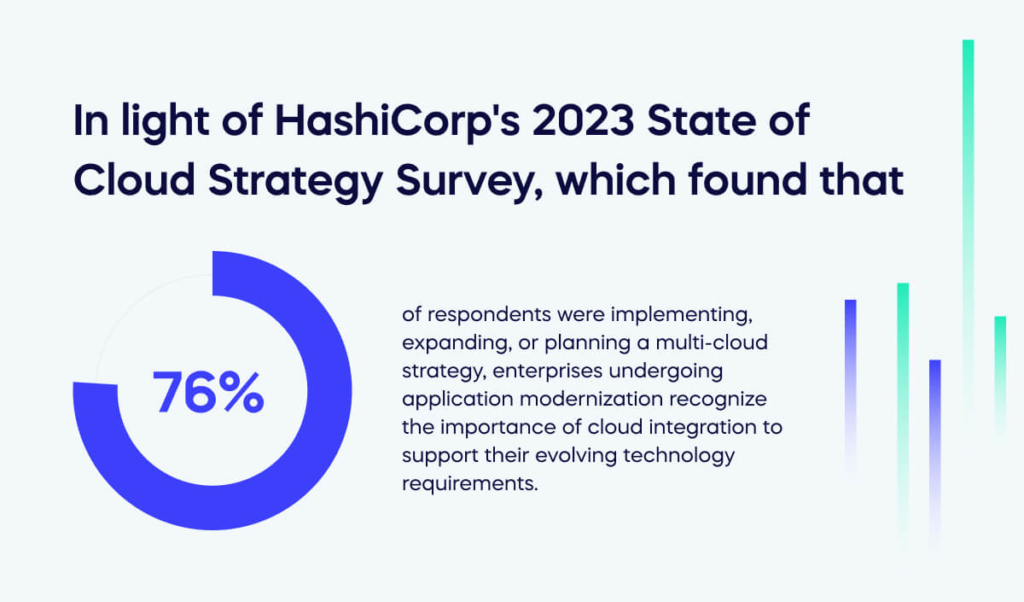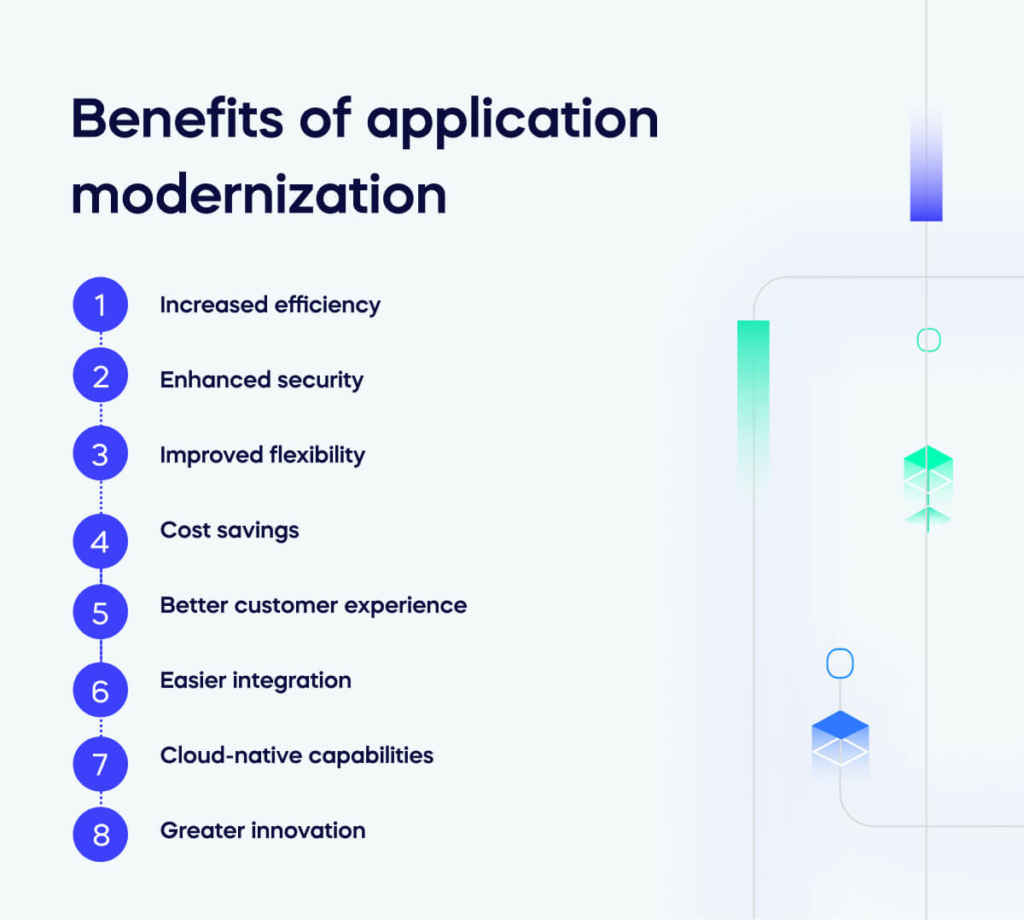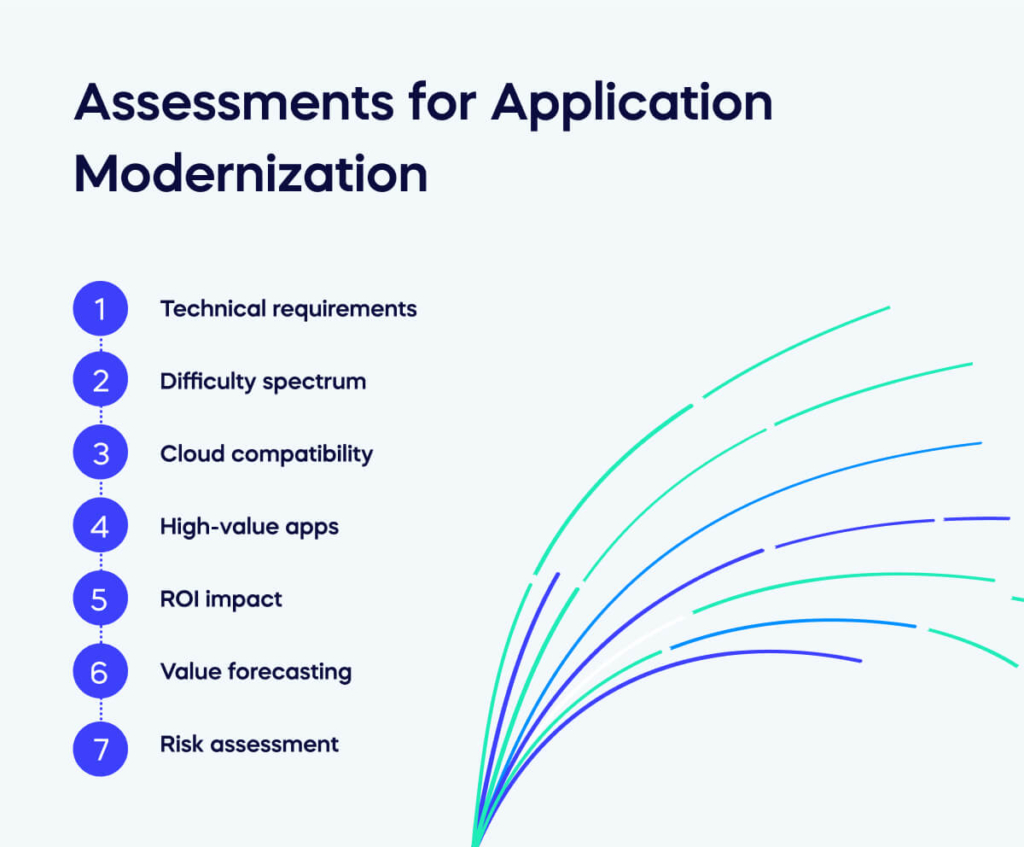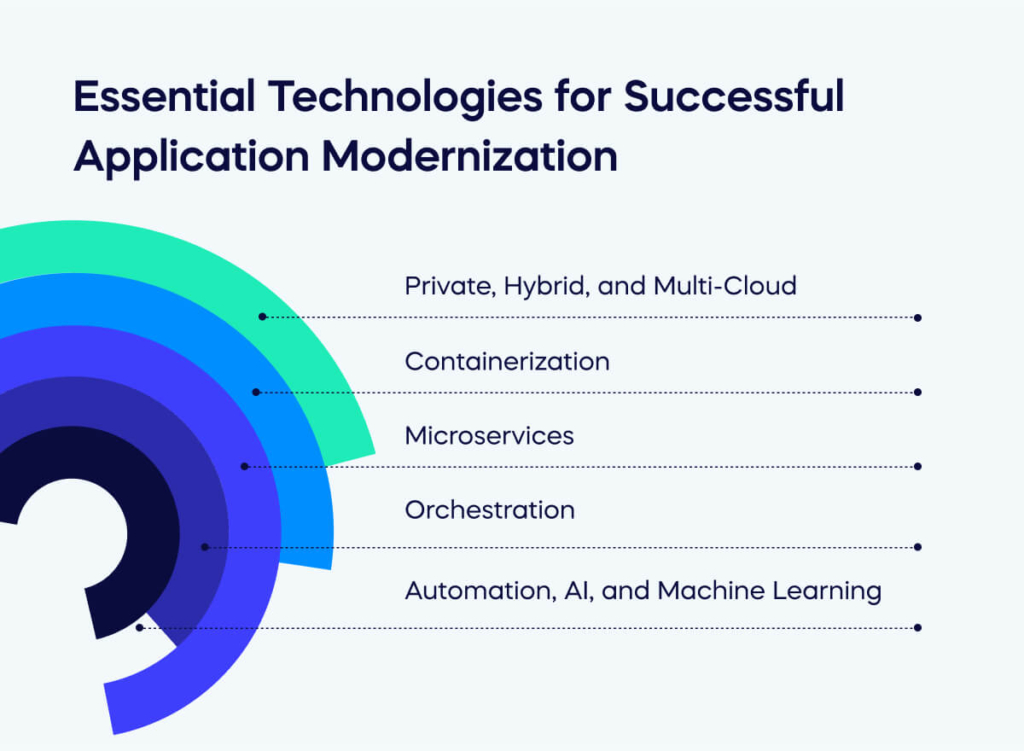Modernizing legacy applications proves ever-critical in contemporary business environments, where scalability, adaptability, and agility are necessary for success.
Due to the digital transformation currently emanating industry-wide, companies are presented with endless opportunities for growth and value creation in current and future markets.
In an era marked by digital adoption and transformational change, companies have successfully optimized their operations and delivered exceptional customer experiences by leveraging advanced technologies and redefining conventional approaches.
It’s clear the disruption of new and novel tech (e.g., AI, blockchain, and cloud computing) is accelerating the speed at which progress is made, and business and executive decision-makers know all too well that there’s no alternative to embracing these changes.
Application modernization embodies this proactive approach, guaranteeing businesses fully utilize their software capabilities and align them with current and emerging business requirements.
In light of HashiCorp’s 2023 State of Cloud Strategy Survey, which found that 76% of respondents were implementing, expanding, or planning a multi-cloud strategy, enterprises undergoing application modernization recognize the importance of cloud integration to support their evolving technology requirements.

In this article, we present an insightful overview of application modernization, covering its definition, the importance of updating legacy applications, methods for assessment, and strategies for successful modernization. We also examine essential technologies that help organizations adapt and flourish in contemporary technological environments.
What is application modernization?
Application modernization is the revitalization of legacy software systems to boost their capabilities, enhance compatibility, and adapt to contemporary business needs. Sometimes called legacy modernization, application modernization entails replacing inflexible on-site application portfolios with updated software architecture, languages, and platform infrastructures that reflect modern development practices.
The primary objective of application modernization is to optimize existing software assets by incorporating high-value technologies specifically tailored to an organization’s unique needs and goals.
These technologies encompass cloud computing, artificial intelligence, microservices, and other advanced solutions that have the potential to foster innovation and enhance adaptability within the application landscape.
MarketsandMarkets reveals that the application modernization services market size is anticipated to expand from USD 15.2 billion in 2022 to USD 32.8 billion by 2027 — registering a CAGR of 16.7% during the forecast period.
Modernization methods, such as re-platforming, re-hosting, re-architecting, re-engineering, and replacing, cater to different complexities, costs, and impacts on existing systems.
What Motivates Application Modernization?
The complex and expensive challenges associated with transforming monolithic applications, including architectural restructuring, re-platforming, scaling, and updating apps, represent the most significant motivations for undertaking application modernization.
Applications are often designed with specific parameters, making integrations, interoperability, and seamless communication difficult in business environments that depend on maneuverability and agility. This limitation can hinder an organization’s ability to adapt quickly to changing market conditions, adopt new technologies, and collaborate effectively across various systems and platforms.
Failing to pursue application modernization can result in underutilized apps or unused software licenses, leading to inefficiencies, diminished return on investment (ROI), and potential missed opportunities for businesses to maximize their technological investments.
Approximately 49.96% of all installed software remains unused by employees. This lack of utilization leads to an annual loss exceeding half a billion U.S. dollars (U.S.$ 537 million) in wasted software resources.
Benefits of application modernization

The Financial Conduct Authority (FCA) has unveiled a report illustrating that a staggering 92% of the UK’s financial services (FS) firms persist in their reliance on legacy technology. Furthermore, the FCA divulged that a significant 78% of FS firm data is still retained within on-premise environments.
On managing legacy tech, GOV.UK states technology can become legacy due to one or more of the following reasons: it is now considered an end-of-life product, no longer supported by the supplier, impossible to update, no longer cost-effective, or has surpassed the acceptable risk threshold.
The necessity of updating antiquated software systems grows more evident as digital transformation and digital adoption persist in reshaping value creation within the business arena.
Reflecting on this fact, it is crucial to delve into the numerous advantages of application modernization. Some of these key benefits include:
- Increased efficiency: Modernizing applications allows businesses to streamline their processes, reduce redundancies, and automate repetitive tasks, leading to improved productivity and resource utilization.
- Enhanced security: Up-to-date software systems come with better security features and protections against cyber threats, ensuring the safety of sensitive data and reducing the risk of breaches.
- Improved flexibility: Modern applications are typically more adaptable and scalable, enabling companies to respond quickly to changing market demands and capitalize on new opportunities.
- Cost savings: By replacing legacy systems with more efficient and cost-effective solutions, businesses can lower operational expenses and achieve a better return on investment.
- Better customer experience: Application modernization enables organizations to provide faster, more reliable, and user-friendly services, which can lead to increased customer satisfaction and loyalty.
- Easier integration: Modern software systems are often designed to be more compatible with other applications and platforms, facilitating seamless integration and collaboration across the organization.
- Cloud-native capabilities: Modernizing applications enables businesses to leverage cloud-native technologies, providing greater flexibility, scalability, and cost optimization by taking advantage of cloud-based infrastructure and services.
- Greater innovation: Application modernization fosters a culture of innovation by allowing organizations to adopt cutting-edge technologies and practices, ensuring they remain at the forefront of their industry.
Assessments for Application Modernization

The process of modernizing applications starts with conducting a comprehensive application assessment. This crucial step involves systematically reviewing your entire software portfolio and establishing well-defined criteria to determine which applications warrant modernization.
This assessment encompasses various factors and should include determining the following:
- Technical requirements: Determine the necessary updates and enhancements for each application to effectively meet current and future business needs.
- Difficulty spectrum: Gauge the complexity and challenges associated with modernizing specific applications (especially those of high value), taking into account factors such as dependencies, legacy architecture, and available resources.
- Cloud compatibility: Evaluate the suitability of each application for migration to the cloud, considering factors like performance, scalability, and security requirements.
- High-value apps: Identify mission-critical applications that can significantly impact business operations and ROI when modernized, prioritizing them in the modernization roadmap.
- ROI impact: Analyze the potential return on investment for modernizing each application, considering factors such as cost savings, increased efficiency, and revenue growth.
- Value forecasting: Estimate the anticipated value of modernizing each app by assessing improvements in business processes, customer experience, and competitive advantage.
- Risk assessment: Identify potential risks and challenges involved in the modernization process, such as data migration issues, integration complexities, and potential downtime.
Developing an application modernization roadmap that outlines prospective KPIs for legacy modernization is also essential. However, establishing rigid strategies may not be the best course for modernization teams requiring the flexibility to adapt to evolving requirements and unforeseen challenges.
Instead, adopting a more agile approach that focuses on iterative progress, continuous improvement, and collaboration can help modernization teams navigate the complexities of the process while remaining responsive.
Exploring Patterns in Application Modernization
Several recognized patterns for application modernization can be observed, centering on an array of distinct strategies, technologies, and approaches. These consist of the following:
- Lift-and-shift (Rehosting): This tactic involves migrating an application to a new infrastructure with minimal or no modifications to the application itself, such as transitioning from on-premises servers to the cloud. Although typically faster and more cost-effective, it might only partially exploit the benefits of modern technologies.
- Platform adaptation (Replatforming): This strategy requires minor application changes to leverage new platforms while preserving its core functionality. Examples include adopting containerization or using a Platform-as-a-Service (PaaS) solution. Replatforming can enhance scalability, flexibility, and maintainability without a total overhaul.
- Code optimization (Refactoring): This method centers on re-architecting and re-coding portions of an application to improve its design, structure, and performance. It enables organizations to leverage modern technologies like microservices and serverless architecture. Microservices allow large, tightly-coupled applications (monoliths) to be decomposed into smaller, independent services that can be developed, deployed, and scaled independently — making it one of the primary motivators for pursuing application modernization.
- Application redevelopment (Rebuilding): This approach entails completely redesigning and redeveloping an application using contemporary technologies, frameworks, and best practices. Rebuilding offers the opportunity to address legacy issues and incorporate new features but demands significant time and resource investments.
- Software substitution (Replacing): In some instances, replacing a legacy application with a new off-the-shelf or custom-built solution that meets current and future business requirements might be more efficient and cost-effective. This method can provide instant access to modern features and capabilities but may require extensive data migration and integration efforts.
- Hybrid approach: Many organizations choose a hybrid system combining elements of the abovementioned strategies. For instance, an organization might rehost certain parts of an application to the cloud, refactor specific components for improved performance, and rebuild others to include new features.
Essential Technologies for Successful Application Modernization

A wide range of intersecting technologies aid business and IT leaders in the application modernization processes. These include:
- Private, Hybrid, and Multi-Cloud
Various cloud models, including private, hybrid, and multi-cloud, are available to suit the unique needs of organizations. These models help facilitate application modernization by providing scalable infrastructure, managed services, and on-demand resources.
- Containerization
Containerization technology, such as Docker, enables organizations to package applications and their dependencies into isolated containers. This helps improve application deployment, portability, and resource utilization, thus aiding modernization.
- Microservices
Microservices architecture breaks down monolithic applications into smaller, independent services. This approach allows for greater development, deployment, and scaling flexibility, making it an essential aspect of application modernization.
- Orchestration
Orchestration tools like Kubernetes manage the deployment, scaling, and operation of containerized applications across clusters of hosts. These tools simplify the management of complex systems, making it easier for organizations to modernize their applications.
- Automation, AI, and Machine Learning
Automation technologies, artificial intelligence (AI), and machine learning can streamline various aspects of the application modernization process. These technologies can analyze, optimize, and automate tasks, reducing manual effort and increasing efficiency.
App Modernization: An Overview
“For many organizations, legacy systems are seen as holding back the business initiatives and business processes that rely on them,” says Stefan Van Der Zijden, VP Analyst, Gartner. “When a tipping point is reached, application leaders must look to application modernization to help remove the obstacles.”
The flexibility, scalability, and security offered by cloud computing have liberated companies from the limitations of rigid legacy applications. As a result, cloud and distributed solutions have emerged as the primary driving forces behind application modernization.
Adopting cloud-based solutions brings a wealth of advantages to businesses going through app modernization. This includes quickly rolling out new features, boosting their agility, and reducing time to market. The cloud also makes API integration a breeze by capitalizing on open-source functionality, which is highly attractive for organizations.
On top of that, by re-platforming apps to boost scaling and performance, businesses can ensure the enduring dependability of their infrastructure. Essentially, transitioning to the cloud enables organizations to optimize costs while simultaneously strengthening security and compliance and fostering enhanced collaboration and accessibility in a user-friendly and coherent manner.
A significant challenge in application modernization is the cost and ROI impact when dealing with complex, integrated legacy systems. Businesses face financial investments to update infrastructure, including hardware, software, and staff training expenses.
Modernizing these systems can lead to potential disruptions in operations and productivity, affecting ROI. Moreover, the complexity of intertwined on-premises systems poses risks during modernization, further impacting costs and returns.
As CIOs and IT decision-makers finalize their application modernization strategies, it’s crucial to prioritize open communication and collaboration between cross-functional teams.
This ensures a unified approach that aligns with the organization’s unique goals and requirements. Additionally, adopting an agile mindset and being prepared to pivot when needed will enable you to address unforeseen challenges effectively.
Invest in continuous learning and skill development for your team members, as this empowers them to stay informed about emerging technologies and best practices, ultimately driving the success of your modernization efforts.


